Charles Onwuakpa writes a detailed tactical analysis about the Serie A match that ended Juventus 2-1 AC Milan.
The hosts kept it late as a last-gasp penalty from Paulo Dybala in the 97th minute earned Juve their 32nd consecutive home victory in Serie A. Massimiliano Allegri’s team were the better team in terms of creativity and dominated the game, but AC Milan held on and were eventually punished as captain Mattia De Sciglio gave away the spot kick after a committing a handball in the box: as usual controversy followed up after the match (especially on social media), but in the end AC Milan can’t fully blame referee Davide Massa’s decision as the cause of their loss.
Line Ups
Massimiliano Allegri made some changes to his chosen 4-2-3-1 formation vs Udinese, as Mehdi Benatia replaced Giorgio Chiellini in defence. Kwadwo Asamoah and Andrea Barzagli were the fullbacks with Dani Alves acting as a right winger and Marko Pjaca on the left side after intestinal problems forced Mario Mandzukič to forfeit the game.
On the other hand, Vincenzo Montella played Mattia De Sciglio as left fullback with Lucas Ocampos upfront alongside Carlos Bacca and Gerard Deulofeu in their 4-3-3 system. Suso was on the bench despite injury with Andrea Bertolacci in midfield amongst José Sosa and Mario Pasalic.
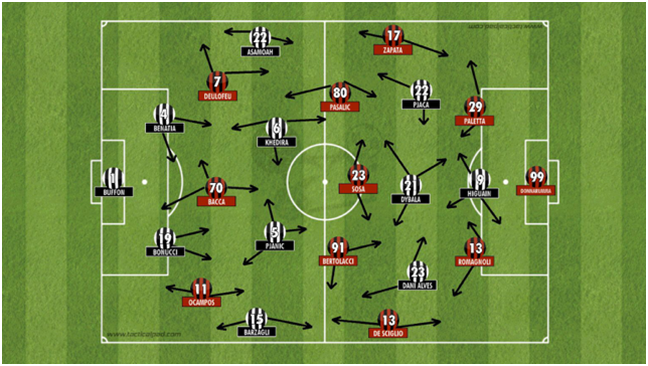
Made using TacticalPad
Juventus: Buffon; Barzagli, Benatia, Bonucci, Asamoah; Khedira, Pjanic; Dani Alves, Dybala, Pjaca; Higuain.
Substitutes: Marchisio, Alex Sandro, Lemina, Rugani, Neto, Lichtsteiner, Rincón, Audero, Kean.
AC Milan: Donnarumma; Zapata, Paletta, Romagnoli, De Sciglio; Pasalic, Sosa, Bertolacci; Deulofeu, Bacca, Ocampos.
Substitutes: Suso, Lapadula, Fernández, Gustavo Gómez, Poli, Vangioni, Storari, Antonelli, Kucka, Plizzari, Calabria.
Juventus improve their buildup phase
One of the many criticisms Massimiliano Allegri faced in the first half of the season was that Juventus played badly despite winning games: their buildup phase was slow and predictable and whenever the regista was man-marked or the BBC (Barzagli-Bonucci-Chiellini) faced intense press from the opponents, Juve was always forced to rely on the technical abilities of Alex Sandro and Cuadrado, whose athleticism, pace and dribbling allowed the ball to be moved from their own third to the final third, although this wasn’t a good idea as it is easier to press an opponent with the ball at feet near the flanks, as his passing options are limited and the pitch is more narrow. The new change of system has not only showcased Mandzukič excellent abilities in defending, pressing and winning aerial duels, but it has even made Miralem Pjanic the midfield playmaker much needed after Andrea Pirlo’s departure. Although Marchisio does an excellent defensive job in that role, Pjanic is more dynamic as he passes and recycles the ball continuously, making the ball circulation to be much more fluid and helping Leonardo Bonucci to orchestrate the team from the back. The Bosnian’s intelligent off-the-ball movement, when man-marked,allows Khedira to drop deeper and offer a central passing solution.
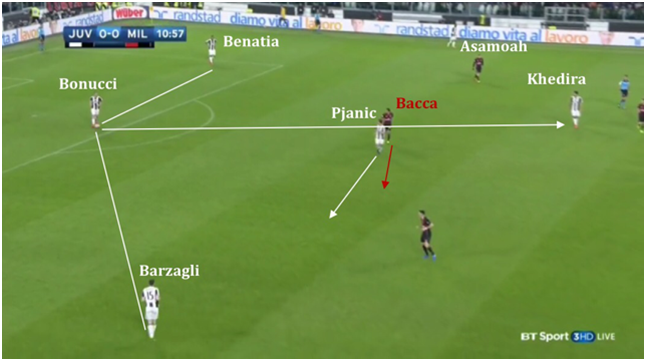
This was visible against AC Milan where Juve enjoyed the ball possession and had an efficient buildup phase. The visitors didn’t press high up the pitch but mainly sat deeep in their midfield in a 4-5-1 formation with Pasalic often helping Bacca upfront, allowing Juventus’ strong positional game at the back to work.
Andrea Barzagli’s hybrid role as a false fullback allowed Juventus to use the full width of the pitch when in possession, as shown in the slide below:
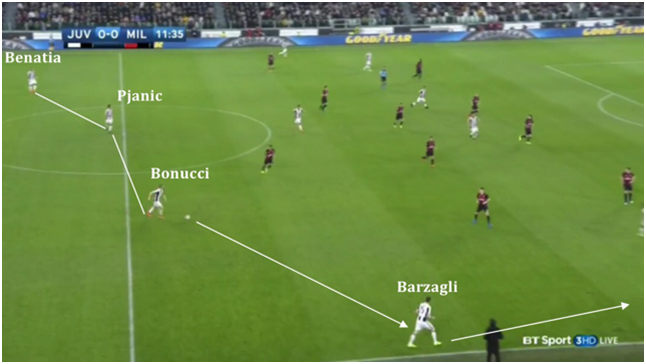
Barzagli could roam forward as Dani Alves freed the flank by cutting inside and acting as a wing regista: something Marcelo of Real Madrid does well.
The Brazilian combined with Paulo Dybala who acted as the enganche between the lines and was by far Juve’s most creative player: la Joya created 6 chances, completed 3/3 take-ons, had 4 shots and ended the game with a pass accuracy of 88%.
Dybala was able to find space in a couple of situations in the first half just like in the following slides, as he created problems for the Rossoneri’s defensive line with his pace on the ball.

Dybala is a key figure for Massimiliano Allegri as he links up play very well, creates chances and scores goals, thanks to his composure when holding the ball and excellent technique. Allegri likes to create automatic, natural tecnhical-tactical connections between his players (ex. one touch football in the final third): this was the case when Dybala and Alves combined to give the Bianconeri the lead: credits also go to Benatia, who, after intercepting the ball and starting the move, was very intelligent to run inside the box through the Zapata-Paletta channel (which had been previously exploited by Khedira).

AC Milan’s struggles and Montella’s corrections
The visitors enjoyed ball possession in the early periods of the game and tried to play proactively as required by Montella’s positional play.
Milan formed a back three with De Sciglio acting as a fullback and Sosa and Bertolacci as pivots: they therefore shifted from a 4-3-3 system to a 3-2-4-1 formation with Pasalic in the right half-space and Ocampos drifting wide.
The slide below shows a combination in the half-space and Bacca making the attacking run.
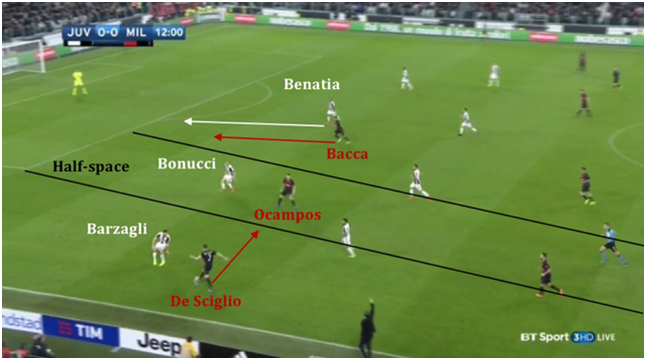
The lack of key players (Locatelli, Bonaventura, Suso) though made their ball circulation quite difficult: AC Milan’s centrebacks aren’t so comfortable on the ball and neither is young goalkeeper Donnarumma, as Juve mixed fases of high pressing up the pitch with a zonal 4-4-2 formation in their midfield (at times 5-3-2 if De Sciglio was very high up the pitch). Dybala and Higuain respectively marked Romagnoli and Paletta, with Pjaca marking Zapata when the ball was moved towards Milan’s right flank. Otherwise he stayed deeper with Khedira and Pjanic, who man-marked the Rossoneri’s pivots.
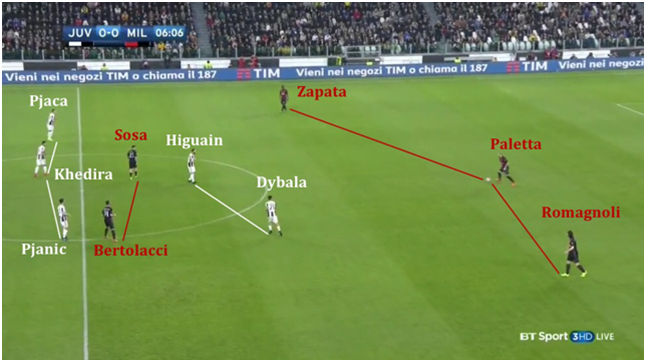
Juventus where happy to leave spaces between the lines, as their numerical superiority at the back allowed the centrebacks to be aggressive on the first, second and third balls of the visitors, who were forced to play long.
After the goal, Montella decided to switch the wingers’ flanks and sent Deulofeu on the left hand side: the Spaniard is blessed with pace and is much more unpredictable than Ocampos, allowing him to take one Barzagli in open field: the Italian is quick and very good in 1vs1 situations, but was outpaced by the Everton loanee on AC Milan’s textbook counterattack lead to Bacca’s equaliser: a casual clearance by Romagnoli picked out Pasalic in the half-space who then set up the lane for the Spaniard to assist the former Sevilla man.
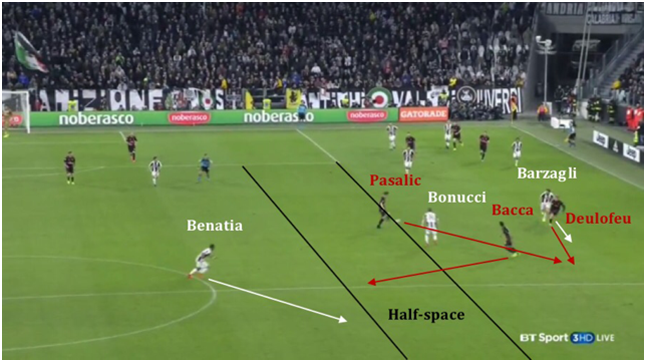
Donnarumma to the rescue
AC Milan though didn’t pose much of a threat to Buffon goal, as they managed only 2 shots on target out of a total 6, compared to the home side’s 11 out of 24 attempted shots. They mainly relied on counterattacks and Donnarumma’s heroics, especially in the second half, as the 18-year-old shotstopper pulled of a handful of excellent saves to maintain the scoreline unchanged. In the meanwhile Allegri sent on Lichtsteiner, Rugani and youth team sensation Moise Kean in replacement of Barzagli, Benatia and Pjaca. Montella tried to freeze the game by adding tacklers such as Kucka, Vangioni and Poli after loosing Bacca for injury around an hour of play. Milan though left dangerous spaces which were intelligently exploited by Khedira, as the Bianconeri pushed for the second goal.
A late red card to José Sosa and the penalty awarded to the Old Lady caused quite a lot of controversy (the foul was evident but it didn’t seem quite intentional
given the distance between De Sciglio and Lichtsteiner). Late drama emerged eventually as Donnarumma renewed his personal duel with Dybala after saving his penalty during the Italian Supercup in Doha: this time though la Joya was clinical enough to bury the shot past Donnarumma, despite the fact that the Italian had guessed the angle.
Conclusion
As always, controversy emerged after such a big game, but it would be unfair to say that Juve didn’t deserve the win: their offensive production was in line with their expected goals value (2.6 xGs against Milan’s 0.7), although their finishing wasn’t as good as usual (Higuain had 6 shots but looked quite frustrated overall).
Juventus now lead Serie A by 11 points ahead of Roma, while AC Milan lose ground in the race for a European spot with Inter, Lazio and Atalanta.
Read all our tactical analyses here























































